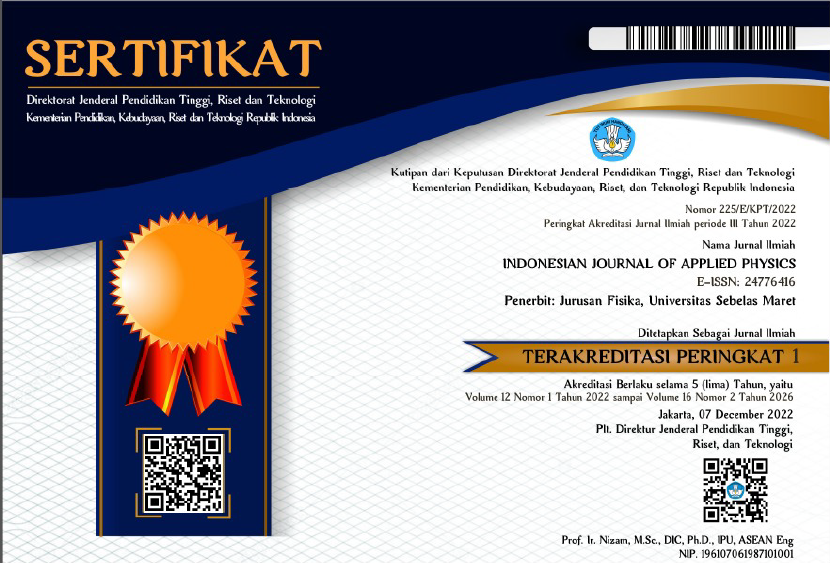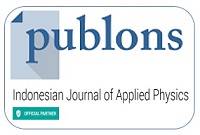Influence of Electrode Shape and Spacing on Corona Discharge Phenomena using a Plasma Generator
Abstract
Electrical discharges that happen near high-voltage conductors are known as corona discharges. It will produce light and sound as it ionises the surrounding air. The purpose of this work is to investigate how conductor form and spacing affect the properties of corona discharge produced by a plasma generator. In this study, conductor shapes such as triangle, W-shaped wire, syringe (point), and L-shaped wire (horizontal) were experimented with, as well as the distance between conductors. The outcome demonstrates that conductor spacing affects the corona discharge's plasma intensity, with shorter distances producing stronger electric fields and greater discharge intensities. Furthermore, the dispersion of the plasma is greatly influenced by the conductor's shape, since every conductor shape results in a different pattern of plasma distribution. These findings offer important new information for the development and improvement of systems that make use of corona discharge events.
Keywords
Full Text:
PDFReferences
- Oehr, C. 2003. Plasma surface modification of polymers for biomedical use. Nuclear Instruments and Methods in Physics Research Section B: Beam Interactions with Materials and Atoms, 208(1-4), 40-47.
- Liston, E. M., Martinu, L., & Wertheimer, M. R. 1993. Plasma surface modification of polymers for improved adhesion: A critical review. Journal of Adhesion Science and Technology, 7(10), 1091-1127.
- Hetemi, D., & Pinson, J. (2017). Surface functionalisation of polymers. Chemical Society Reviews, 46(19), 5701-5713.
- Kawai, Y., Ikegami, H., Sato, N., Matsuda, A., Uchino, K., Kuzuya, M., & Mizuno, A. (Eds.). 2010. Industrial plasma technology: Applications from environmental to energy technologies. John Wiley & Sons.
- Chen, J., & Davidson, J. H. 2002. Ozone Production in the Positive DC Corona Discharge: Model and Comparison to Experiments. Plasma Chemistry and Plasma Processing, 22(4), 495-522.
- Chang, J. S., Lawless, P. A., & Yamamoto, T. 1991. Corona Discharge Processes. IEEE Transactions on Plasma Science, 19(6), 1152-1166.
- Meniconi, M. 1997. Electrostatic discharge: Perhaps the most problematic. International Journal, 14(3), 301-308.
- Grosse, S., Benard, N., & Moreau, E. (2024). Electroaerodynamic thrusters: Influence of a freestream on the current, ionic wind, and force produced by a DC corona discharge. Journal of Electrostatics, 130, 103950.
- Syahbana, R. 2019. Analisa Terbentuknya Korona pada Saluran Kubicle Tegangan 20Kv Serta Pengaruhnya Terhadap Rugi-Rugi Daya. Lensa, 2(48), 14-21.
- Chua, B., & Son, A. 2014. Sensing absolute air pressure using micro corona discharge. Sensors and Actuators A: Physical, 217, 49-55.
- Teke, S., Nur, M., & Winarni, A. T. 2014. Produksi Ozon Dalam Reaktor Dielectric Barrier Discharge Plasma (Dbdp) Terkait Panjang Reaktor Dan Laju Alir Udara Serta Pemanfaatannya Untuk Menjaga Kualitas Asam Amino Ikan. Berkala Fisika, 17(1), 25-32.
- Akdoğan, E., Şirin, H. T., Şahal, G., Deniz, Z., Kaya, A., & Serdaroğlu, D. Ç. 2024. Accelerating the environmental biodegradation of poly-3-hydroxybutyrate (PHB) via plasma surface treatment. Bioresource Technology Reports, 25(October 2023), 101719.
- Yoshida, S., Hagiwara, K., Hasebe, T., & Hotta, A. 2013. Surface modification of polymers by plasma treatments for the enhancement of biocompatibility and controlled drug release. Surface and Coatings Technology, 233, 99-107.
- Chairani, D. 2022. Analisis Pengaruh Korona Terhadap Rugi-Rugi Daya pada Saluran Transmisi. Jurnal Pendidikan Sains dan Komputer, 2(02), 212-217.
- Pasra, N., Fikri, M., Mauriraya, K. T., Rijanto, T., & Buditjahjanto, I. G. P. A. 2023. Deteksi Suara Corona Discharge berdasarkan Noise menggunakan Metode LPC dan Euclidean Distance. ELKOMIKA Jurnal Teknik Energi Elektrik, Teknik Telekomunikasi, dan Teknik Elektronika, 11(1), 72.
Refbacks
- There are currently no refbacks.
















